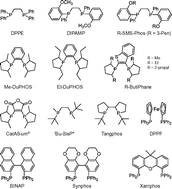Rhodium diphosphine complexes: a case study for catalyst activation and deactivation†
Abstract
The present work provides an overview of possible activation and deactivation phenomena in homogeneous catalytic processes promoted by different types of rhodium complexes containing diphosphine ligands. While awaiting more efficient 1st row metal-based catalysts, a more economic and greener approach to the use of expensive catalysts based on precious metals requires an in-depth knowledge of both the reaction mechanism and the activation and deactivation phenomena which may reduce the temporary solution concentration of the metal effectively available for catalysis. The present work provides in particular a quantitative description of activation and deactivation phenomena such as generation of active species from suitable precatalysts (induction periods); catalyst deactivation due to formation of non-reactive, monomeric species with either the solvent, the substrate, the product or additives; and catalyst aggregation to usually non-reactive multinuclear complexes. Some critical remarks concerning the often applied ‘in situ’ procedure for ‘catalyst’ generation are also included.

- This article is part of the themed collection: Mechanistic Studies in Catalysis

 Please wait while we load your content...
Please wait while we load your content...